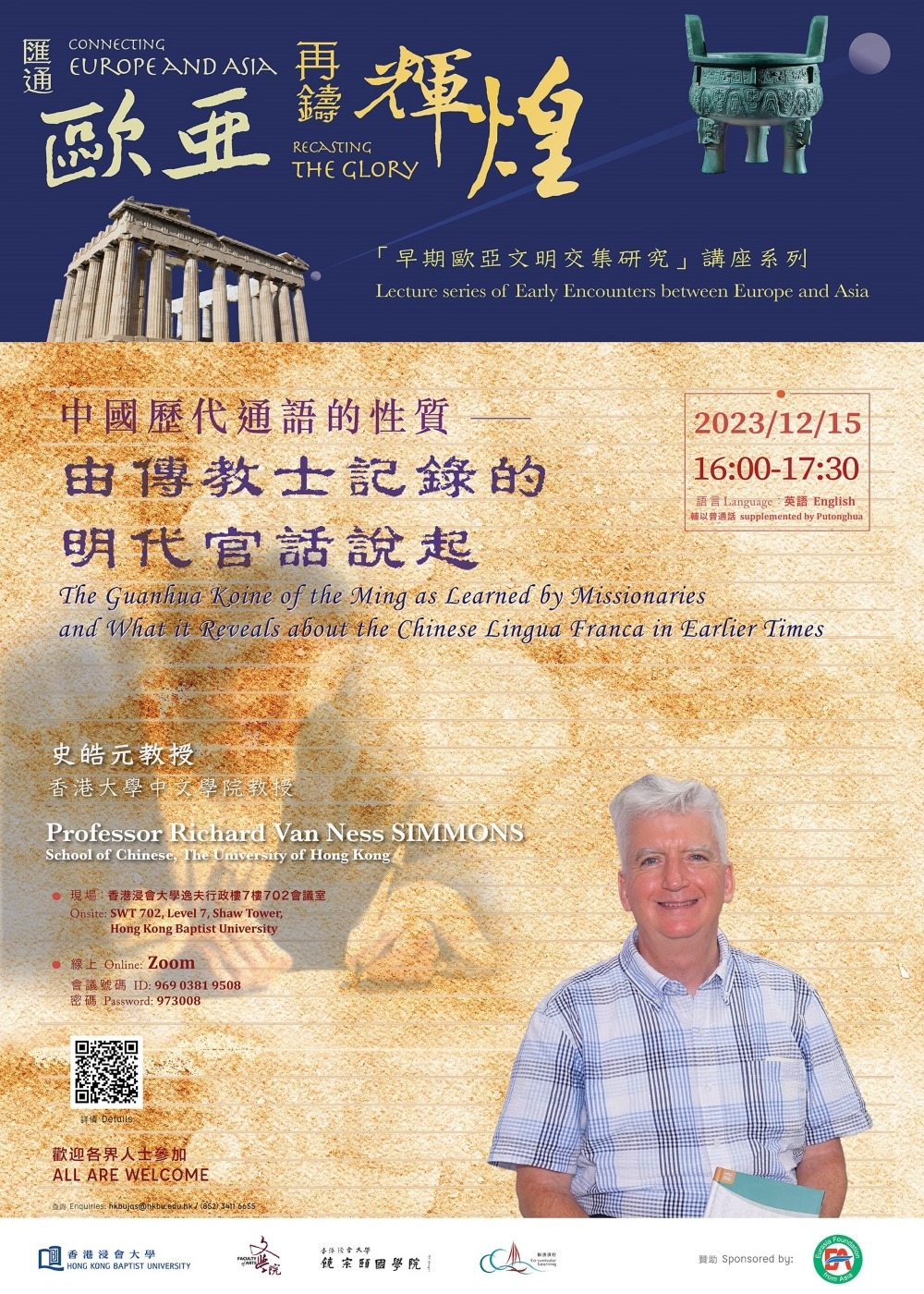
Connecting Europe and Asia, Recasting the Glory: Lecture series of Early Encounters between Europe and Asia
Lecture 12: The Guanhua Koine of the Ming as Learned by Missionaries and What it Reveals about the Chinese Lingua Franca in Earlier Times
2023/12/15│16:00–17:30
Professor Richard Van Ness SIMMONS
School of Chinese, The University of Hong Kong
- Abstract:Dialects have historically been an integral part of China's linguistic landscape. The Chinese early on pointed out that there was an ‘elegant speech’, yǎyán 雅言, which was the prestige language of the elite, and there were also fāngyán 方言 ‘dialects’ and a tōngyǔ 通語, a lingua franca or koine used in broader communication across dialects and languages. Beginning in the Ming Dynasty, this lingua franca came to be called 官話 Guānhuà, literally “the language used by officials,” now translated as ‘Mandarin’. Guānhuà at that time was not simply a single language, but rather existed in at least two loosely understood varieties. This lecture will explore the Mandarin described by Western missionaries when they came into contact with spoken Chinese during the Ming and Qing dynasties, as well as the origin and evolution of Guānhuà. The aim is to gain a deeper understanding of the diverse dialect origins of Mandarin as well as of Western perceptions of China’s rich linguistic environment in traditional times.
- Language: English (supplemented by Putonghua)
- Summary (Recorded by Zhang Zixuan)
Professor Richard Van Ness Simmons of the School of Chinese of the University of Hong Kong gave a lecture titled: ‘The Guanhua Koine of the Ming as learned by Missionaries and what it reveals about the Chinese Lingua Franca in Earlier Times.’ First, as his point of entry, he took explanation given in classical texts such as Lunyu (The Analects) and Fangyan (Regional speech). Closely following this, using concepts such as ‘local talk’, ‘guanhua koine’ (‘official language’), and ‘lingua franca’ from the Ming dynasty onwards as the heart of the matter, he referenced a sequence of vivid case studies that included missionaries such as Michele Ruggieri, Matteo Ricci, Lazzaro Cattaneo, Nicolas Trigault, Francisco Varo, and Robert Morrison, and unfolded an intoxicating linguistic landscape in front of our eyes.
The lecture dwelt most on the guanhua koine and lingua franca since the Ming dynasty as well as studies and descriptions of this language by Christian missionaries. Guanhua koine was a high-status language employed by the Chinese elite and ruling classes, while the lingua franca was a language type that straddled variations in dialect and was used in spoken interaction of a much wider context. The lecture raised issues related to the evolution of the guanhua koine and lingua franca as well as the linguistic environments of different epochs. In addition, it introduced the studies and usage of the Chinese language by the missionaries. They were assiduous in delving into guanhua koine and regarded it as a tool that enabled communication so they could transmit the tenets of Christianity more effectively. The lecture also emphasized the observations and research on different manifestations of guanhua koine carried out by the missionaries, especially its southern and northern inflexions.
This research is of great significance to understanding the multi-faceted nature and evolution of the language of China. The lecture explored deeply the characteristics of guanhua koine and lingua franca since the Ming dynasty and the contribution made by missionaries and their research results in the field of the language of China. At the same time, it focused on exploring discrepancies between guanhua koine dialect and guanhua koine lingua franca. The speaker indicated that realization of guanhua koine in dialect was divided into southern and northern types, as represented by Nanjing and Beijing patois respectively.
The guanhua koine of the south was current in the Jiangnan and Henan regions, whereas that of the north was generally universal in the Beijing and Tianjin regions. Even so, as time passed, the guanhua koine of the south gradually lost its status. The lecturer also pointed out that the guanhua koine lingua franca was very important in mercantile settings and ordinary interaction, but in their daily lives, most people tended more towards employing local linguistic norms. In addition, the speaker introduced differences in pronunciation between Nanjing and Beijing patois and drew attention to corresponding romanization systems.
- Lecture video
HKBUTube
This lecture series is sponsored by Eurasia Foundation (from Asia).